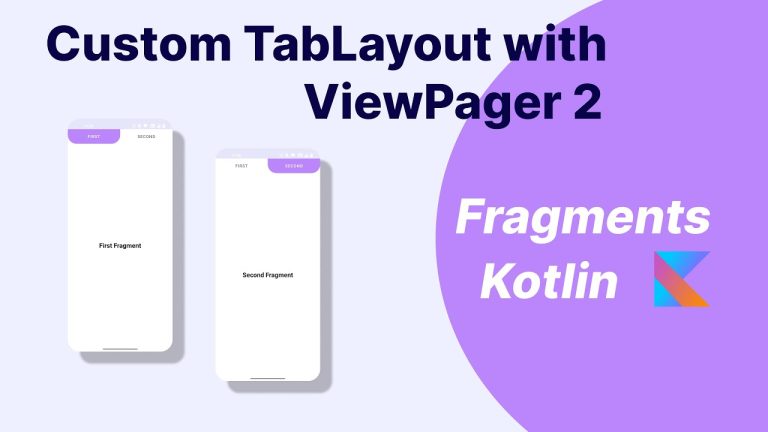Slide transition between screens is common in Android applications. We can use the navigation components or a swipe-able view to create this transition. A common swipe-able view is ViewPager2. The ViewPager library has been around for quite a while.
Introduction
This view allows the developer to display views or fragments to the user in a swipe-able format. This feature is common in content display applications and in app setups.
ViewPager2 is often integrated with TabLayout. A TabLayout indicates the current page and allows a user to switch through pages.
Prerequisites
To follow through with this tutorial, you will need to:
- Have Android Studio installed.
- Have a basic knowledge of building Android applications.
- Have a basic understanding of Kotlin programming language.
Let’s get started!
- First, let’s set up the necessary dependencies in your app-level build.gradle file:
implementation 'androidx.viewpager2:viewpager2:1.0.0'
implementation 'com.google.android.material:material:1.4.0'- Next, create a new layout file for your main activity (
activity_main.xml). The layout will contain a TabLayout and a ViewPager2:
<androidx.coordinatorlayout.widget.CoordinatorLayout xmlns:android="http://schemas.android.com/apk/res/android"
android:layout_width="match_parent"
android:layout_height="match_parent">
<com.google.android.material.appbar.AppBarLayout
android:layout_width="match_parent"
android:layout_height="wrap_content">
<com.google.android.material.tabs.TabLayout
android:id="@+id/tabLayout"
android:layout_width="match_parent"
android:layout_height="wrap_content"
android:background="@color/colorPrimary"
app:tabTextColor="@color/tab_text_color"
app:tabSelectedTextColor="@color/tab_selected_text_color"
app:tabIndicatorColor="@color/tab_indicator_color" />
</com.google.android.material.appbar.AppBarLayout>
<androidx.viewpager2.widget.ViewPager2
android:id="@+id/viewPager"
android:layout_width="match_parent"
android:layout_height="match_parent"
android:layout_marginTop="?attr/actionBarSize"
app:layout_behavior="@string/appbar_scrolling_view_behavior" />
</androidx.coordinatorlayout.widget.CoordinatorLayout>- Create a new layout file for each of your blog fragments (
fragment_blog.xml). Customize it to your needs:
<LinearLayout xmlns:android="http://schemas.android.com/apk/res/android"
android:layout_width="match_parent"
android:layout_height="match_parent"
android:orientation="vertical">
<!-- Add your blog content views here -->
</LinearLayout>- Create a new class for your ViewPager adapter (
BlogPagerAdapter.java):
import androidx.annotation.NonNull;
import androidx.fragment.app.Fragment;
import androidx.fragment.app.FragmentActivity;
import androidx.viewpager2.adapter.FragmentStateAdapter;
import java.util.List;
public class BlogPagerAdapter extends FragmentStateAdapter {
private List<Fragment> fragments;
public BlogPagerAdapter(@NonNull FragmentActivity fragmentActivity, List<Fragment> fragments) {
super(fragmentActivity);
this.fragments = fragments;
}
@NonNull
@Override
public Fragment createFragment(int position) {
return fragments.get(position);
}
@Override
public int getItemCount() {
return fragments.size();
}
}- Finally, in your MainActivity, set up the TabLayout and ViewPager2:
import android.os.Bundle;
import androidx.appcompat.app.AppCompatActivity;
import androidx.fragment.app.Fragment;
import androidx.viewpager2.widget.ViewPager2;
import com.google.android.material.tabs.TabLayout;
import com.google.android.material.tabs.TabLayoutMediator;
import java.util.ArrayList;
import java.util.List;
public class MainActivity extends AppCompatActivity {
private ViewPager2 viewPager;
private TabLayout tabLayout;
@Override
protected void onCreate(Bundle savedInstanceState) {
super.onCreate(savedInstanceState);
setContentView(R.layout.activity_main);
viewPager = findViewById(R.id.viewPager);
tabLayout = findViewById(R.id.tabLayout);
List<Fragment> fragments = new ArrayList<>();
fragments.add(new BlogFragment1());
fragments.add(new BlogFragment2());
fragments.add(new BlogFragment3());
BlogPagerAdapter adapter = new BlogPagerAdapter(this, fragments);
viewPager.setAdapter(adapter);
new TabLayoutMediator(tabLayout, viewPager, (tab, position) -> {
// Customize the tab names as per your requirement
switch (position) {
case 0:
tab.setText("Blog 1");
break;
case 1:
tab.setText("Blog 2");
break;
case 2:
tab.setText("Blog 3");
break;
}
}).attach();
}
}That’s it! You can now create separate fragments (BlogFragment1, BlogFragment2, etc.) and customize them for each blog page.
Note: Make sure to replace the colors and other resources with your own preferences in the XML files. Also, remember to register the MainActivity in your AndroidManifest.xml file.
This is a basic example to get you started. You can further enhance it with additional features and customization based on your requirements.




